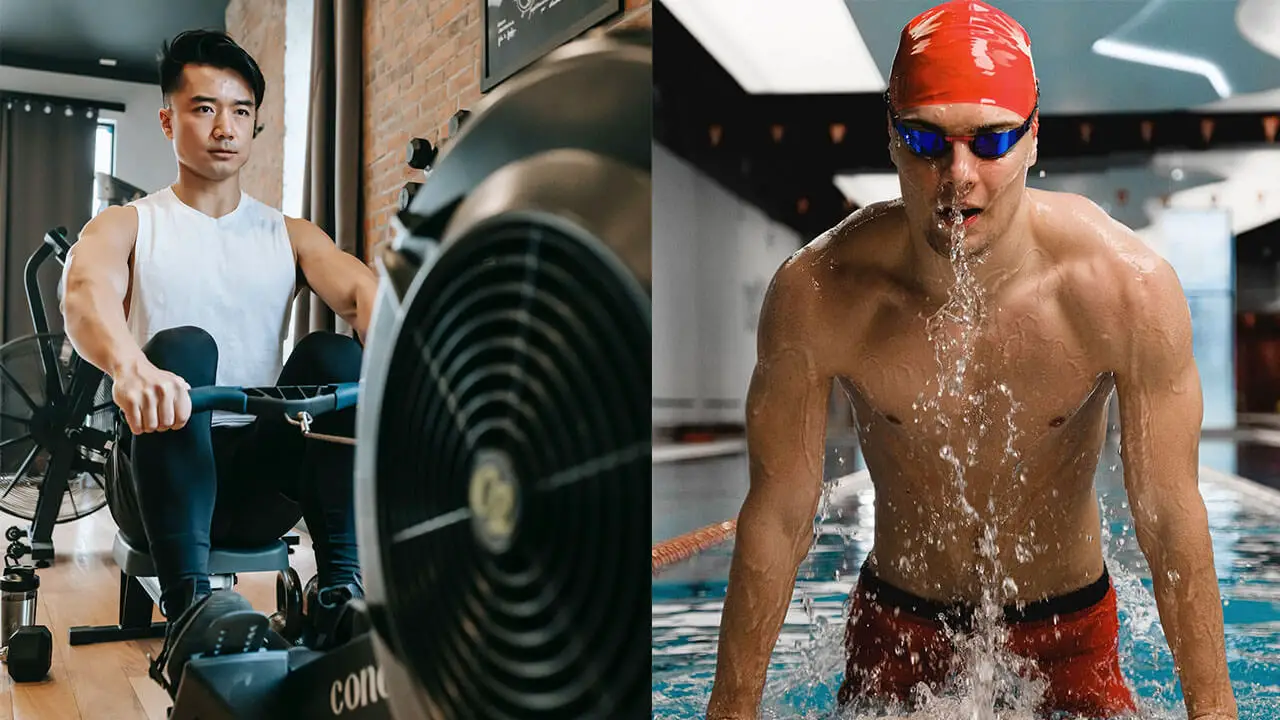If you’re deciding whether you should commit to using a rowing machine vs. swimming or vice versa, you’ve come to the right article.
Both of these activities allow you to get much needed, low-impact exercise that helps you shed the pounds, improve your cardiovascular health, and even build some muscle. However, between the rowing machine vs. swimming, there are some differences you should consider before choosing one over the other. From the impact on your joints, to their ease of access, cost, and level of skill required, each exercise has some pros and cons to keep in mind.
But what if I told you there are a few significant factors that can make all the difference in the choice that you make? Read on to find out what they are!
Pros of using a rowing machine
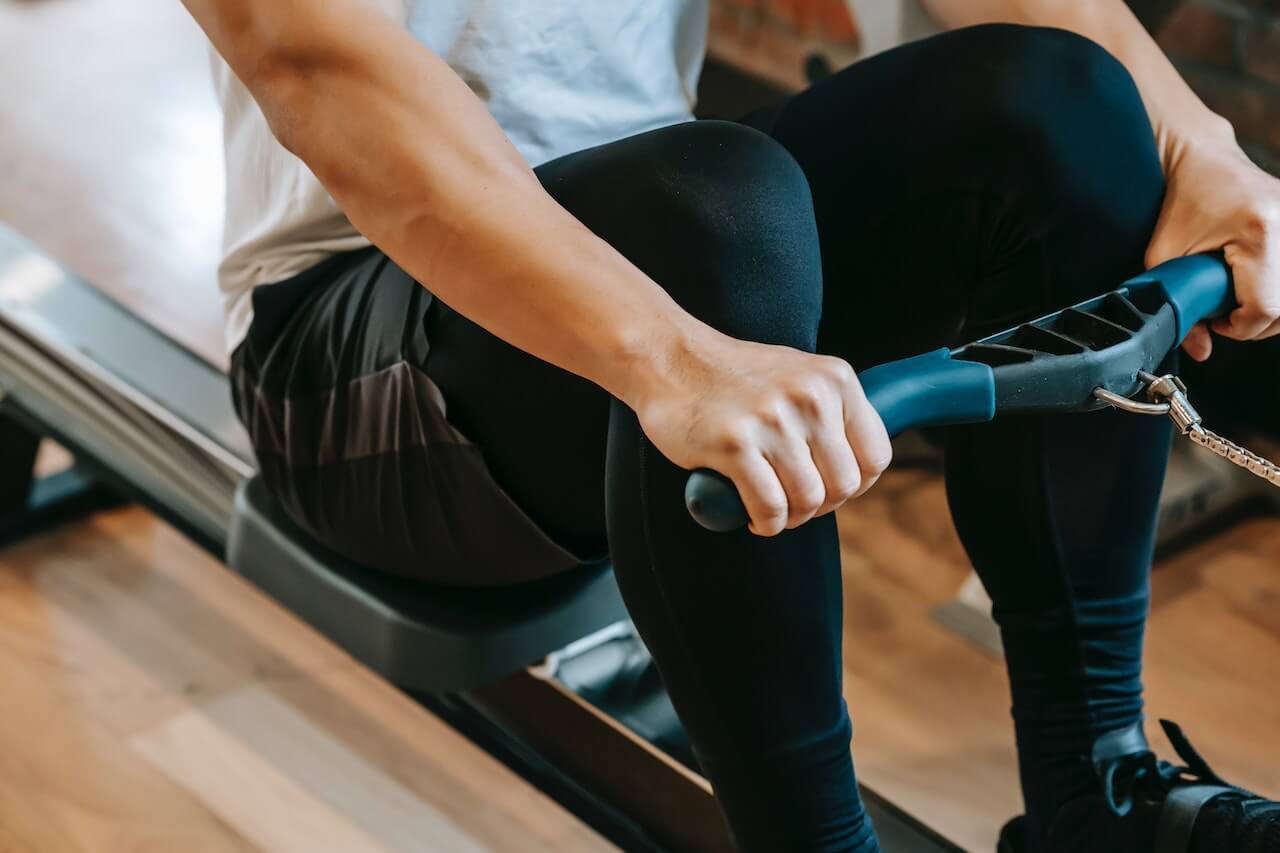
- It is a low-impact exercise that puts less stress on your joints, making it suitable for people with joint problems.
- It provides a full-body workout that engages multiple muscle groups, including the legs, back, arms, and core.
- Assuming you have a rowing machine at home, it is a workout option that can be done regardless of the weather conditions.
- It is a great way to improve cardiovascular endurance and help you shed those pounds.
- It is easy to adjust the resistance level as needed. Increasing the intensity of the workout gives you a clear sense of progression that is easy to quantify. The increased resistance can also result in muscle growth.
- You can watch shows or movies on the TV or listen to music, a podcast, or an audiobook to break up the repetitive nature of this activity. But unless you have earphones, you may have to turn up the volume really loud depending on your machine. I have managed to “read” dozens books this way, and it is a great way to maximize anyone’s time.
Cons of using a rowing machine
- Rowing machines have a high upfront cost.
- They take up space in your home which is not ideal for those with limited space.
- Rowing can be repetitive and monotonous, which may lead to boredom over time. Not a problem for me because I am usually listening to an audiobook or podcast.
- Air rowing machines are notoriously loud and this can disturb people in your home or neighbors if you live in an apartment. Click here for a video demonstration of how loud it can get. Magnetic rowing machines are significantly quieter, but they are usually more expensive.
- It may not be as effective in improving swimming-specific skills, such as breath control and stroke technique.
Pros of swimming
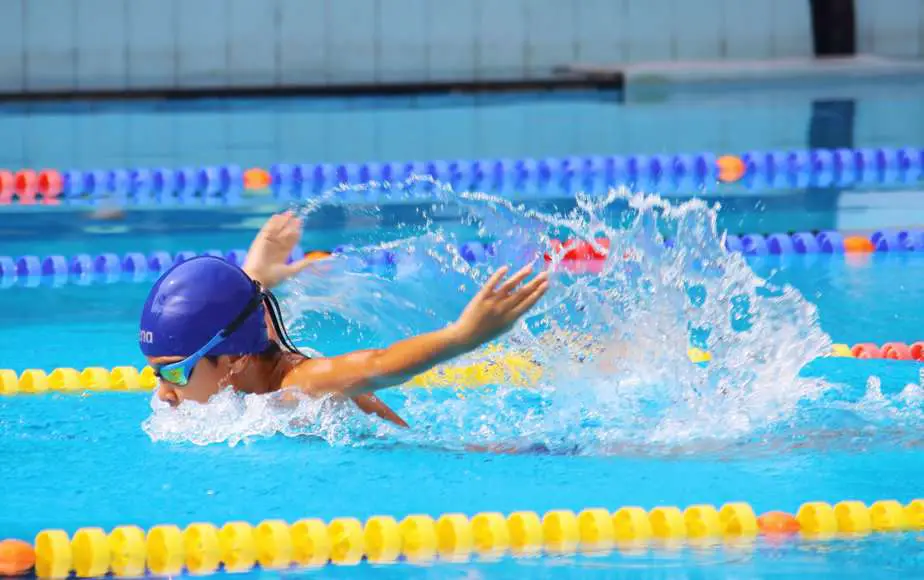
- It is also a low-impact exercise that is easy on the joints and ideal for people with arthritis or other joint problems assuming you have proper technique.
- It is a full body workout that engages multiple muscle groups including the arms, legs, core, and back.
- It can improve cardiovascular endurance and help you shed those pounds.
- It is an excellent way to improve swimming-specific skills, such as breath control, stroke technique, and overall swimming proficiency.
- It is a survival skill to be able to swim. Knowing how to swim can save your life (or someone else’s) at some point in the future.
Cons of swimming
- It requires access to a pool. If you don’t have any near you, then tough luck.
- It can be challenging for beginners who may struggle with proper breathing and stroke techniques. Drowning is a possible risk, but lifeguards can prevent that.
- It may not provide as intense of a workout as rowing, depending on the stroke and intensity level.
- Because you cannot increase the resistance of water, you won’t build as much muscle compared to using a rowing machine.
- If you have a fear of the water or are an adult who doesn’t know how to swim, then it can be very hard to get started.
- Constant exposure to chlorine can dry out your skin and hair, causing discomfort such as itchy skin and hair, split ends, rashes, and cracked skin.
- Chlorine may cause asthma. If you already have asthma, it may worsen the symptoms. Anecdotally, former swimmers who were not asthmatics prior to swimming have said that their asthma went away on its own after they stopped being exposed to chlorine.
As you can see, using a rowing machine and swimming are both great cardiovascular exercises that can help improve overall health and fitness. Here are some similarities and differences between the two:
Similarities between using a rowing machine vs. swimming:
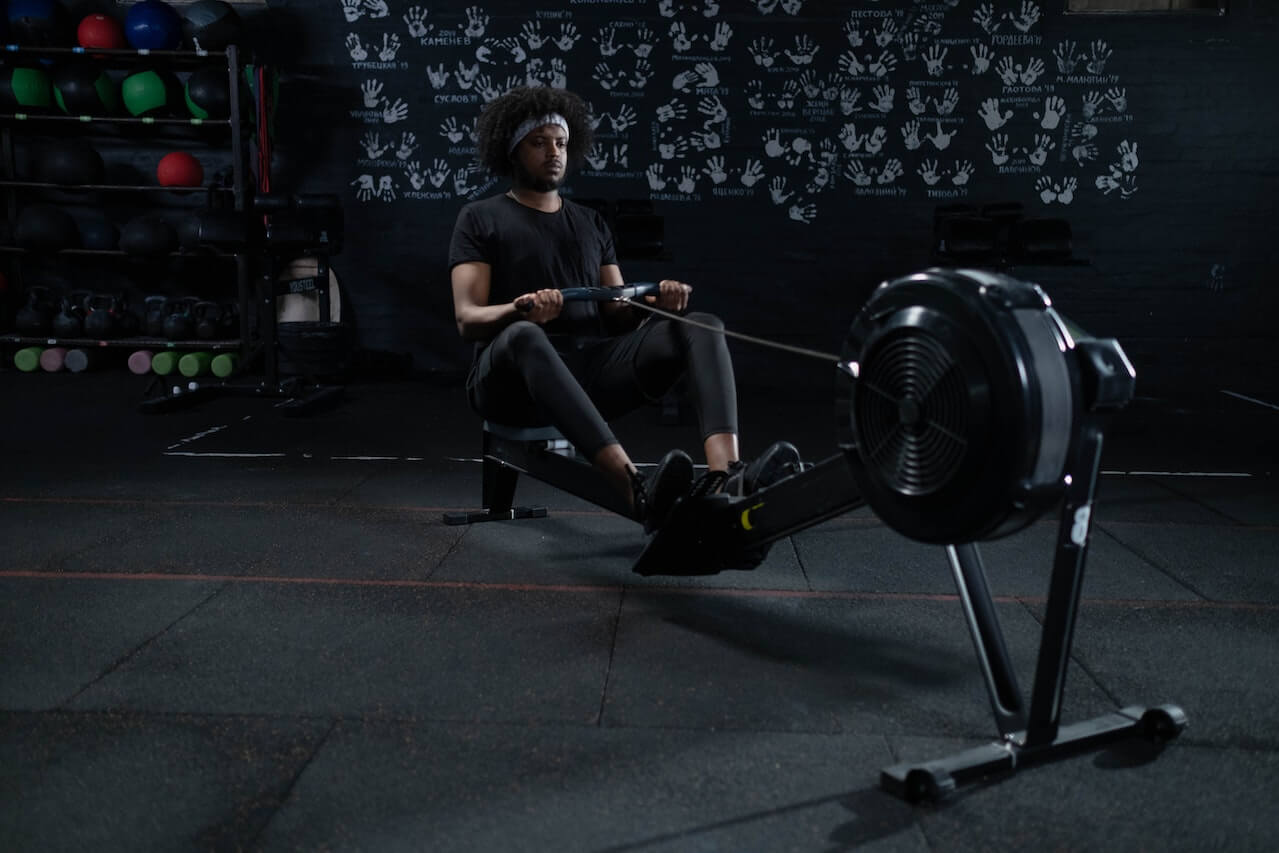
Putting the pros and cons together, how does rowing compare to swimming? Find out below:
- Both provide low-impact workouts that are gentle on the joints and suitable for people with joint problems.
- Both engage multiple muscle groups and can provide full-body workouts.
- Both can improve cardiovascular endurance and lung capacity.
- Both can help burn calories and promote weight loss.
- Both can be social if you join a rowing class or swim team.
Differences between using a rowing machine vs. swimming:
- Rowing is a weight-bearing exercise that can help improve bone density, while swimming is non-weight-bearing. Wearing weights while swimming can increase your risk of drowning.
- Rowing primarily works the upper body, including the back, arms, and shoulders, while swimming engages the entire body, including the legs, arms, core, and back.
- Rowing can be done indoors, making it a convenient workout option regardless of weather conditions, while swimming requires access to an outdoor or indoor pool.
- Rowing can be monotonous and repetitive, while swimming can provide more variety if you change up your swimming strokes.
- Rowing does not expose you to potentially harmful chemicals such as chlorine.
Does rowing or swimming burn more calories?
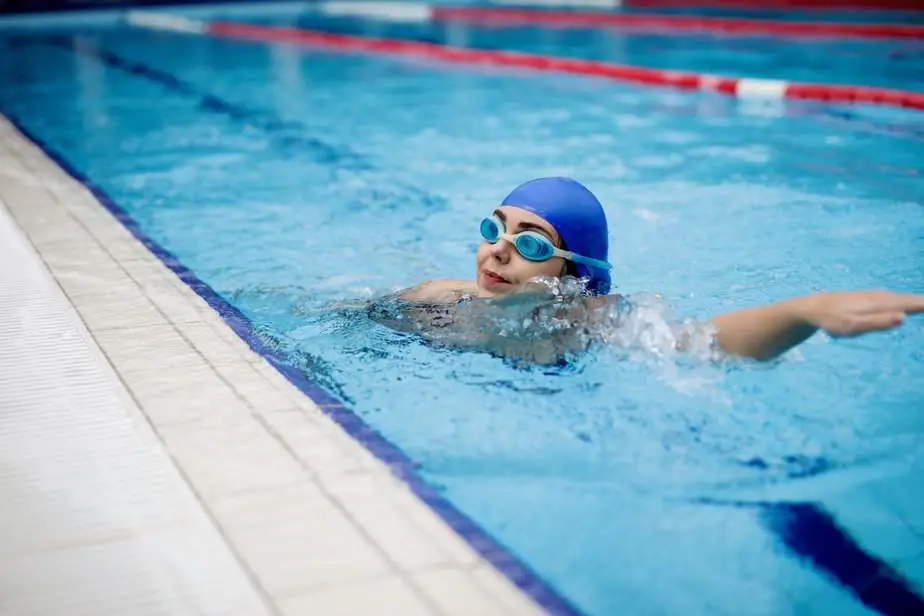
According to Harvard Health Publishing, the amount of calories burned by rowing vs. swimming is comparable. Look at the data below to see how close they are.
| Calories burned in 30-minute activities | |||
| Activity | 125-pound person | 155-pound person | 185-pound person |
| Rowing (moderate) | 210 | 252 | 294 |
| Swimming (moderate) | 180 | 216 | 252 |
| Rowing (vigorous) | 255 | 369 | 440 |
| Swimming (vigorous) | 300 | 360 | 420 |
As you can see, from 155 pounds and above, rowing vs. swimming vigorously burns nearly the same amount of calories. With regards to weight loss, you cannot go wrong with either one. You will have to find a tiebreaker elsewhere.
Barriers of entry between rowing vs. swimming
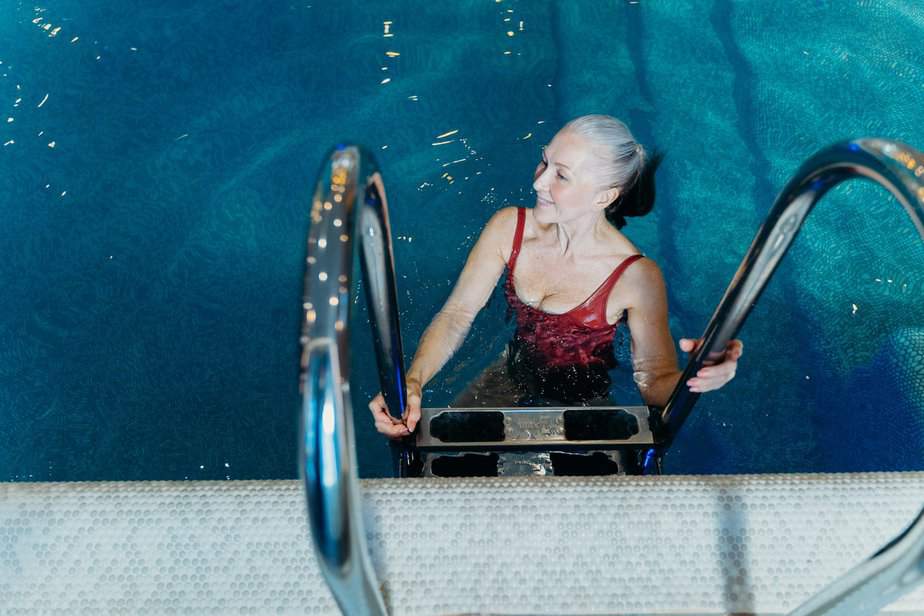
Fear of water
One concern that can make the decision between rowing vs. swimming extremely obvious is whether you have a fear of the water or not. Some people have a lifelong fear of the water that prevents them from even going to the beach, lake, or any other body of water.
For them, unless they overcome their fear of the water, they may never be able to reap the benefits of swimming.
Since we are comparing swimming to using a rowing machine, there is no such fear of water to be had so rowing would be a good alternative instead.
Level of skill required
Another aspect to consider when comparing the rowing machine vs. swimming is the level of skill required.
Rowing on a machine is a relatively simple exercise that requires minimal skill or technique. Once you learn the proper form and technique, you can perform the exercise at your own pace and intensity without much risk of injury.
Swimming, on the other hand, can require a higher level of skill and technique to perform correctly. Proper breathing, stroke technique, and body positioning are essential for a safe and effective swimming workout. Learning to swim correctly can take time, practice, and guidance from a qualified instructor.
Some coaches specialize in helping adults overcome their fear of the water – just let them know specifically that this is something you struggle with so they can factor that into their lesson plan.
While rowing is a relatively easy exercise to learn, swimming can provide additional benefits by improving swimming-specific skills, such as breath control, stroke technique, and overall swimming proficiency.
Cost
Another important concern between using a rowing machine vs. swimming is cost. Rowing has a higher initial cost if you are buying your own machine. However, initial cost aside, this step can save you money in the long run.
For one, you never have to pay for a gym membership again if you were only planning on rowing at the gym. You also don’t have to pay for the cost of transportation to go to the gym, or waste time commuting, and you never have to wait your turn to use the rowing machine. If time is money, then you’ll be saving plenty of both.
I estimate that you can already cover the cost of a rowing machine within one year compared to the yearly cost of a membership for the gym or for the pool plus the aforementioned transportation costs. Even if you don’t recoup the costs within a year, as long as you use it consistently for many years you will eventually save money.
For example, even if you have convenient access to a gym or swimming pool because it is within walking or biking distance, those membership fees can add up and you will still eventually pay more in the long run compared to owning a rowing machine of your own.
If you have a backyard pool, it will probably not be big enough to efficiently swim laps in. Also, the cost of maintenance for the pool can add up as well. So your best option is still to go to a public swimming pool which, as I explained above, is more expensive than buying a rowing machine in the long term.

